The grain cooling spear market stands positioned for substantial expansion, advancing from USD 254.2 million in 2025 to USD 585.4 million by 2035, reflecting accelerating adoption of grain temperature stabilization and storage preservation solutions across agricultural and food processing environments. Demand growth is being driven by rising concerns surrounding post-harvest grain deterioration, where elevated moisture levels and internal grain respiration accelerate heat buildup during storage. Grain quality losses translate directly into reduced milling yields, nutritional degradation, and increased susceptibility to fungal and pest infestation, prompting food processors, feed manufacturers, and grain aggregators to adopt controlled cooling mechanisms for inventory protection. Climate variability, particularly in regions with extended warm seasons, further reinforces the need for on-site cooling measures that reduce spoilage risk without heavy capital investment in full aeration systems.
Additionally, procurement standards across mills, exporters, and feed producers are becoming more stringent, emphasizing consistency in grain temperature, moisture content, and microbial stability. This shift encourages the use of cooling spears as a cost-effective alternative to large centralized cooling infrastructure, especially in distributed storage environments such as cooperative warehouses and mid-scale farm storage units. Growing emphasis on reducing post-harvest losses supported by government and agricultural development programs continues to strengthen long-term demand for portable, stainless steel, and sensor-integrated cooling spear systems.

The subsequent period from 2030 to 2035 extends growth from USD 385.7 million to USD 585.4 million, adding USD 199.7 million or 60% of the decade's total expansion. This phase centers on widespread market penetration of specialized cooling technologies, enhanced integration with grain storage management platforms, and expanded compatibility with diverse agricultural operation standards. Market development signals fundamental shifts in how storage operators approach grain preservation optimization and quality control management, with industry participants positioned to capture demand across multiple material type categories and application segments.
The grain cooling spear market demonstrates distinct growth phases with varying market characteristics and competitive dynamics. Between 2025 and 2030, the market advances through its technology adoption phase, expanding from USD 254.2 million to USD 385.7 million with steady annual increments averaging 8.7% growth. This period showcases transition from basic galvanized steel systems to advanced stainless steel configurations with enhanced durability capabilities and integrated temperature monitoring systems becoming mainstream features.
The 2025-2030 phase contributes USD 131.5 million to market value, representing 40% of total decade expansion. Market maturation factors include standardization of grain storage protocols, declining equipment costs for cooling spear systems, and increasing operator awareness of grain preservation benefits reaching diverse food processing and agricultural storage applications. Competitive landscape evolution during this period features established agricultural equipment manufacturers like Martin Lishman and Teqnivent expanding their cooling spear portfolios while specialty manufacturers focus on advanced material development and enhanced monitoring capabilities.
From 2030 to 2035, market dynamics shift toward comprehensive automation integration and global agricultural expansion, with growth continuing from USD 385.7 million to USD 585.4 million, adding USD 199.7 million or 60% of total expansion. This phase transition centers on specialized material systems, integration with automated storage networks, and deployment across diverse food processing and feed manufacturing scenarios, becoming standard rather than specialized applications. The competitive environment matures with focus shifting from basic cooling capability to comprehensive storage optimization systems and integration with grain quality monitoring platforms.
| Metric | Value |
|---|---|
| Market Value (2025) | USD 254.2 million |
| Market Forecast (2035) | USD 585.4 million |
| Growth Rate | 8.7% CAGR |
| Leading Technology | Stainless Steel Material Type |
| Primary Application | Food Processing Segment |
The market demonstrates strong fundamentals with stainless steel systems capturing a dominant share through advanced durability and corrosion resistance capabilities. Food processing applications drive primary demand, supported by increasing grain storage volumes and temperature control technology requirements. Geographic expansion remains concentrated in developed markets with established agricultural infrastructure, while emerging economies show accelerating adoption rates driven by food security expansion and rising storage quality standards.
Market expansion rests on three fundamental shifts driving adoption across food processing, agricultural research, and feed manufacturing sectors. First, grain preservation demand creates compelling operational advantages through cooling spears that provide immediate temperature control and moisture management without compromising storage capacity, enabling operators to meet stringent quality standards while maintaining facility productivity and reducing grain spoilage. Second, agricultural storage modernization accelerates as grain handling facilities worldwide seek advanced cooling systems that complement traditional storage processes, enabling precise temperature monitoring and pest control that align with industry standards and food safety protocols.
Third, food security enhancement drives adoption from grain storage operators and agricultural cooperatives requiring effective preservation solutions that maximize grain quality while maintaining operational productivity during storage and handling operations. Growth faces headwinds from equipment cost challenges that vary across cooling spear suppliers regarding material specifications and monitoring technologies, which may limit adoption in cost-sensitive storage environments. Technical limitations persist regarding installation complexity and facility compatibility that may reduce effectiveness in retrofit, legacy storage, or constrained space conditions, affecting system capability and operational requirements.
The grain cooling spear market represents a specialized yet critical agricultural opportunity driven by expanding global grain production, food storage modernization, and demand for superior preservation quality in diverse agricultural applications. As storage operators worldwide seek to achieve consistent grain quality, reduce storage losses, and integrate advanced cooling systems with facility platforms, grain cooling spears evolve from basic temperature control devices to sophisticated storage solutions ensuring quality preservation and operational leadership.
The market's growth trajectory from USD 254.2 million in 2025 to USD 585.4 million by 2035 at an 8.7% CAGR reflects fundamental shifts in agricultural storage requirements and grain preservation optimization. Geographic expansion opportunities remain particularly pronounced in Asia Pacific markets, while the dominance of stainless steel systems and food processing applications provides clear strategic focus areas.
Strengthening the dominant stainless steel segment through enhanced material durability, superior corrosion resistance, and integrated monitoring systems. This pathway focuses on optimizing material specifications, improving operational longevity, extending effectiveness across diverse storage conditions, and developing specialized configurations for varied applications. Market leadership consolidation through advanced material engineering and automated integration enables premium positioning while defending competitive advantages. Expected revenue pool: USD 52-72 million
Rapid grain production and food storage growth across Asia Pacific creates substantial expansion opportunities through local manufacturing capabilities and distribution partnerships. Growing storage facility development and food security initiatives drive continued demand for advanced cooling systems. Localization strategies reduce equipment costs, enable faster service support, and position companies advantageously for agricultural procurement programs. Expected revenue pool: USD 45-62 million
Expansion within the dominant food processing segment through specialized cooling spear designs addressing storage standards and facility requirements. This pathway encompasses automated monitoring integration, quality verification coordination, and compatibility with diverse grain handling workflows. Premium positioning reflects superior preservation capability and comprehensive food safety compliance. Expected revenue pool: USD 40-55 million
Strategic expansion into agricultural research applications requires enhanced precision capabilities and data-focused features addressing experimental operational requirements. This pathway addresses controlled environment performance, research data integration, and experimental protocol compatibility with advanced monitoring for demanding research applications. Premium pricing reflects specialized research requirements. Expected revenue pool: USD 35-48 million
Development of specialized grain cooling spears for feed manufacturing applications addressing feed quality and storage requirements. This pathway encompasses feed safety optimization, moisture control integration, and regulatory compliance capabilities for feed production segments. Technology differentiation through feed-grade specifications enables diversified revenue streams while reducing dependency on food processing platforms. Expected revenue pool: USD 30-42 million
Expansion of galvanized steel segment through optimized production economics, competitive pricing strategies, and standard storage applications. This pathway encompasses cost-effective solutions, adequate performance formulations, and economical alternatives requiring balanced material characteristics. Market development through efficient manufacturing enables differentiated positioning while accessing price-sensitive agricultural operations requiring cost-effective cooling solutions. Expected revenue pool: USD 28-38 million
Development of connected cooling spear systems with real-time monitoring, cloud-based analytics, and automated alert capabilities. This pathway encompasses remote temperature tracking, predictive maintenance integration, and comprehensive storage analytics. Premium positioning reflects technological leadership and digital expertise while enabling access to technology-focused agricultural operations requiring advanced monitoring solutions. Expected revenue pool: USD 25-35 million
Primary Classification: The market segments by material type into Galvanized Steel and Stainless Steel categories, representing evolution from basic cooling equipment to corrosion-resistant solutions for comprehensive grain storage optimization.
Secondary Classification: Application segmentation divides the market into Food Processing, Agricultural Scientific Research, Feed Industry, and Others sectors, reflecting distinct requirements for temperature control, storage capacity, and preservation standards.
Regional Classification: Geographic distribution covers Asia Pacific, Europe, North America, and other regions, with developed markets leading adoption while emerging economies show accelerating growth patterns driven by agricultural expansion programs.
The segmentation structure reveals progression from standard galvanized materials toward premium stainless steel systems with enhanced durability and monitoring capabilities, while application diversity spans from food processing facilities to specialized research and feed manufacturing operations requiring precise temperature control solutions.
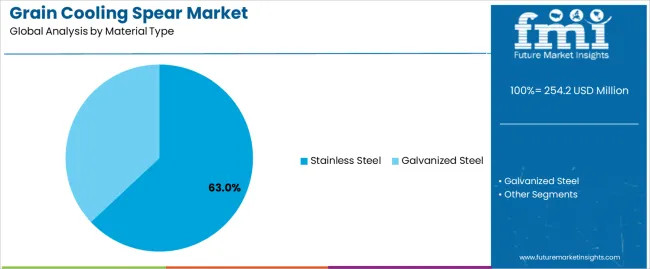
Market Position: Stainless steel systems command the leading position in the grain cooling spear market with approximately 63.0% market share through advanced material properties, including superior corrosion resistance, extended operational lifespan, and durability optimization that enable operators to achieve optimal grain preservation across diverse food processing and agricultural storage environments.
Value Drivers: The segment benefits from operator preference for long-lasting cooling systems that provide consistent temperature control, reduced maintenance requirements, and facility reliability without requiring frequent equipment replacement. Advanced material features enable automated monitoring integration, durability consistency, and compatibility with existing storage infrastructure, where equipment longevity and corrosion resistance represent critical operational requirements.
Competitive Advantages: Stainless steel systems differentiate through proven material durability, consistent performance characteristics, and integration with storage management platforms that enhance operational effectiveness while maintaining optimal preservation quality suitable for diverse agricultural applications.
Key market characteristics:
Galvanized steel systems maintain economical positioning in the grain cooling spear market due to their cost-effective material properties and adequate performance advantages. These systems appeal to operators requiring standard cooling equipment with sufficient performance for routine grain storage applications. Market adoption is driven by small-scale agricultural operations and budget-conscious facilities, emphasizing reliable temperature control and operational simplicity through standard cooling systems while maintaining competitive pricing structures.
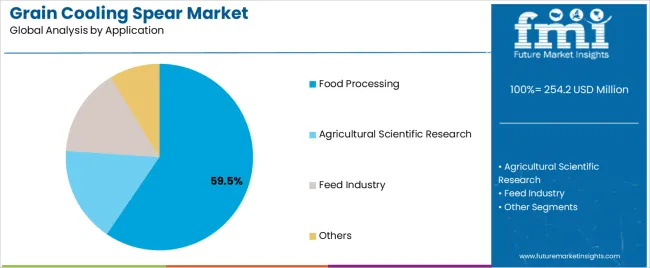
Market Context: Food processing applications dominate the grain cooling spear market with approximately 59.5% market share due to widespread adoption of temperature control equipment and increasing focus on grain quality, storage preservation, and food safety management that minimize product degradation while maintaining food processing standards.
Appeal Factors: Food processing operators prioritize preservation reliability, temperature consistency, and integration with existing storage infrastructure that enables coordinated cooling application across multiple grain handling operations. The segment benefits from substantial food industry investment and storage modernization programs that emphasize acquisition of cooling systems for quality assurance and preservation optimization applications.
Growth Drivers: Food processing expansion programs incorporate grain cooling spears as standard storage equipment for facility operations, while specialty grain processing growth increases demand for advanced temperature control capabilities that comply with food safety standards and minimize storage losses.
Market Challenges: Varying storage protocols and facility design differences may limit equipment standardization across different processing operations or regional scenarios.
Application dynamics include:
Agricultural scientific research applications capture approximately 20.5% market share through specialized temperature control requirements in experimental grain storage, seed preservation research, and agricultural testing facilities. These operations demand precise cooling systems capable of providing controlled environment conditions while delivering research-grade monitoring and data collection capabilities.
Feed industry applications account for approximately 12.5% market share, while other segments capture 7.5%, including agricultural supply operations, grain trading facilities, and specialty storage applications requiring grain cooling spear capabilities for preservation quality and operational compliance.
Growth Accelerators: Grain production expansion drives primary adoption as cooling spears provide superior preservation capabilities that enable storage operators to meet stringent quality standards without excessive facility costs, supporting agricultural operations and food security objectives that require precise temperature control applications. Storage infrastructure demand accelerates market expansion as grain handling facilities seek effective cooling systems that minimize storage losses while maintaining operational effectiveness during grain storage and preservation scenarios. Agricultural investment increases worldwide, creating continued demand for temperature control systems that complement traditional storage processes and provide preservation reliability in competitive markets.
Growth Inhibitors: Equipment cost challenges vary across cooling spear suppliers regarding material specifications and monitoring technology features, which may limit operational flexibility and market penetration in regions with price-sensitive agricultural operations. Technical performance limitations persist regarding installation requirements and facility retrofit complexity that may reduce effectiveness in legacy storage, limited access, or constrained facility conditions, affecting system capability and operational requirements. Market fragmentation across multiple storage standards and agricultural practices creates compatibility concerns between different cooling spear manufacturers and existing facility infrastructure.
Market Evolution Patterns: Adoption accelerates in commercial grain storage and food processing sectors where preservation quality justifies equipment costs, with geographic concentration in developed markets transitioning toward mainstream adoption in emerging economies driven by agricultural expansion and food security awareness. Technology development focuses on enhanced monitoring capabilities, improved material durability, and compatibility with automated storage systems that optimize temperature control and preservation effectiveness. The market could face disruption if alternative grain preservation technologies or active cooling systems significantly limit deployment of cooling spear-based temperature control in storage applications, though cooling spears' unique combination of passive operation, installation flexibility, and cost-effectiveness continues making them preferred in grain storage operations.
The grain cooling spear market demonstrates varied regional dynamics with Growth Leaders including China (11.7% CAGR) and India (10.9% CAGR) driving expansion through grain storage capacity additions and agricultural modernization programs. Steady Performers encompass Germany (10.0% CAGR), Brazil (9.1% CAGR), and United States (8.3% CAGR), benefiting from established agricultural industries and advanced storage technology adoption. Mature Markets feature United Kingdom (7.4% CAGR) and Japan (6.5% CAGR), where specialized food processing applications and premium storage integration support consistent growth patterns.

| Country | CAGR (2025-2035) |
|---|---|
| China | 11.7% |
| India | 10.9% |
| Germany | 10.0% |
| Brazil | 9.1% |
| United States | 8.3% |
| United Kingdom | 7.4% |
| Japan | 6.5% |
Regional synthesis reveals Asia Pacific markets leading adoption through grain production expansion and storage infrastructure development, while European countries maintain steady expansion supported by food processing technology advancement and agricultural quality standardization requirements. North American markets show moderate growth driven by commercial grain storage applications and facility modernization trends.
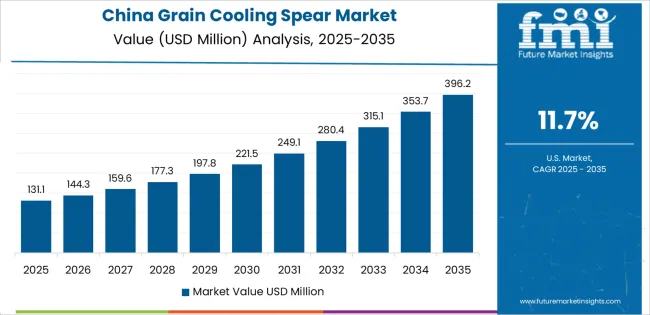
The Chinese market emphasizes advanced cooling features, including precision temperature monitoring and integration with comprehensive grain storage platforms that manage facility operations, preservation optimization, and quality assurance applications through unified agricultural systems. The country demonstrates strong growth at 11.7% CAGR, driven by grain storage expansion, food security initiatives, and emerging agricultural modernization development that support cooling spear integration. Chinese storage operators prioritize operational effectiveness with grain cooling spears delivering consistent preservation performance through advanced material capabilities and facility adaptation features.
Distribution channels include major grain storage operators, food processing facilities, and agricultural equipment procurement programs that support professional applications for large-scale grain storage and food manufacturing operations. Storage platform integration capabilities with established agricultural systems expand market appeal across diverse operational requirements seeking preservation quality and efficiency benefits. The expanding grain production volumes and accelerating food processing sector create continued demand, while innovative applications in smart agriculture and controlled environment storage open new growth avenues.
Performance Metrics:
Advanced agricultural market in Germany demonstrates sophisticated cooling spear deployment with documented operational effectiveness in food processing applications and commercial grain storage facilities through integration with existing storage systems and agricultural infrastructure. The country leverages engineering expertise in agricultural technology and storage systems integration to maintain strong growth at 10.0% CAGR. Agricultural centers, including Bavaria, Lower Saxony, and North Rhine-Westphalia, showcase premium installations where cooling spear systems integrate with comprehensive storage platforms and quality management systems to optimize preservation effectiveness and grain quality.
German equipment manufacturers prioritize system reliability and food safety compliance in cooling spear development, creating demand for premium temperature control systems with advanced features, including automated monitoring integration and quality verification systems. The market benefits from established food processing infrastructure and willingness to invest in storage technologies that provide long-term preservation benefits and compliance with food safety standards.
Market Intelligence Brief:
The USA grain cooling spear market demonstrates sophisticated deployment across commercial grain storage applications with documented effectiveness in food processing facilities and agricultural operations through integration with comprehensive storage management systems and facility infrastructure. The country leverages advanced technology capabilities in agricultural innovation and storage optimization to maintain moderate growth at 8.3% CAGR. Agricultural centers, including Midwest grain belt regions, showcase premium installations where cooling spear systems integrate with comprehensive storage platforms and grain handling networks to optimize preservation positioning and facility effectiveness.
American storage operators prioritize temperature control reliability and facility efficiency in equipment selection, creating demand for innovative cooling systems with advanced features, including real-time monitoring integration and automated alert systems. The market benefits from established commercial storage infrastructure and willingness to invest in preservation technologies that provide quality enhancement and compliance with agricultural standards.
Market Intelligence Brief:
The UK grain cooling spear market demonstrates advanced food processing deployment with documented operational effectiveness in grain storage applications and specialty food facilities through integration with existing storage systems and facility infrastructure. The country leverages expertise in food processing and storage systems integration to maintain steady growth at 7.4% CAGR. Agricultural centers, including East Anglia, Yorkshire, and Scottish regions, showcase installations where cooling spear systems integrate with comprehensive storage platforms and food safety systems to optimize processing compliance and preservation effectiveness.
British storage operators prioritize system traceability and food safety compliance in equipment development, creating demand for certified cooling systems with advanced features, including quality data management and monitoring integration. The market benefits from established food processing infrastructure and commitment to invest in preservation technologies that provide quality benefits and compliance with UK food safety standards.
Strategic Market Indicators:
Grain cooling spear market in India demonstrates rapid expansion with documented operational effectiveness in grain storage applications and food processing facilities through integration with emerging agricultural systems and storage infrastructure. The country leverages growing agricultural capabilities in storage technology and facility systems integration to achieve high growth at 10.9% CAGR. Agricultural centers, including Punjab, Haryana, and Uttar Pradesh, showcase expanding installations where cooling spear systems integrate with comprehensive storage platforms and supply networks to optimize market penetration and facility effectiveness.
Indian storage operators prioritize preservation quality and cost standards in equipment selection, creating demand for effective cooling systems with advanced features, including basic monitoring integration and quality control capabilities. The market benefits from expanding agricultural infrastructure and willingness to invest in international-standard storage technologies that provide facility differentiation and compliance with food quality standards.
Market Intelligence Brief:
Grain cooling spear market in Brazil demonstrates expansion with documented operational effectiveness in commercial grain storage applications and agricultural facilities through integration with developing storage systems and agricultural infrastructure. The country leverages growing agricultural capabilities in storage technology and facility integration to achieve growth at 9.1% CAGR. Agricultural centers, including Mato Grosso, Paraná, and Rio Grande do Sul, showcase installations where cooling spear systems integrate with storage platforms and grain handling networks to optimize market development and facility effectiveness.
Brazilian storage operators prioritize equipment value and preservation capability in cooling spear selection, creating demand for cost-effective temperature control systems with reliable features, including standard monitoring and facility compatibility. The market benefits from expanding agricultural infrastructure and investment in storage equipment that provide preservation enhancement.
Market Intelligence Brief:
Japan's grain cooling spear market demonstrates precision deployment with documented operational effectiveness in premium food processing applications and specialty storage facilities through integration with advanced facility systems and quality control infrastructure. The country leverages engineering excellence in precision agriculture and storage systems integration to maintain steady growth at 6.5% CAGR. Agricultural centers, including Hokkaido, Niigata, and Akita, showcase installations where cooling spear systems integrate with comprehensive quality platforms and storage management systems to optimize facility excellence and preservation effectiveness.
Japanese storage operators prioritize system precision and equipment excellence in cooling spear development, creating demand for premium temperature control systems with advanced features, including ultra-precise monitoring and quality integration systems. The market benefits from established food processing infrastructure and commitment to invest in highest-quality storage technologies that provide superior facility positioning and compliance with rigorous Japanese food safety standards.
Strategic Market Indicators:
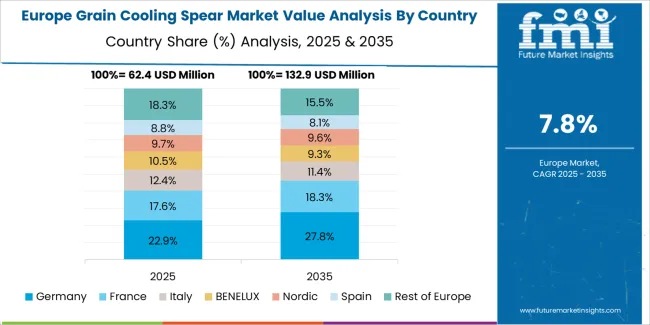
The grain cooling spear market in Europe is projected to grow from USD 65.8 million in 2025 to USD 151.3 million by 2035, registering a CAGR of 8.7% over the forecast period. Germany is expected to maintain its leadership position with a 32.4% market share in 2025, projected to reach 33.9% by 2035, supported by its advanced food processing infrastructure and major agricultural centers in Bavaria and Lower Saxony. France follows with a 18.6% share in 2025, expected to reach 19.3% by 2035, driven by comprehensive grain storage programs and agricultural modernization initiatives. The United Kingdom holds a 15.8% share in 2025, projected to reach 16.4% by 2035 through specialized food processing activities and commercial storage integration. Italy commands a 13.2% share, while Spain accounts for 10.5% in 2025. The Netherlands maintains a 4.8% share. The Rest of Europe region is anticipated to show steady adoption, with its collective share remaining at 4.8% through 2035, reflecting consistent growth in Nordic countries and emerging Central European agricultural markets implementing storage modernization programs.
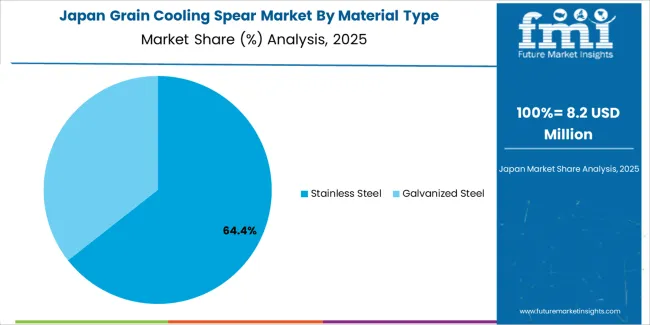
In Japan, the grain cooling spear market prioritizes stainless steel systems, which capture the dominant share of food processing and commercial storage installations due to their advanced features, including precision durability optimization and seamless integration with existing facility infrastructure. Japanese storage operators emphasize quality, longevity, and long-term preservation excellence, creating demand for stainless steel systems that provide consistent temperature control capabilities and superior corrosion resistance based on facility requirements and quality standards. Galvanized steel maintains secondary positions primarily in small-scale operations and budget-conscious facilities where adequate cooling functionality meets operational requirements without compromising storage efficiency.
Market Characteristics:

In South Korea, the market structure favors international agricultural equipment manufacturers, including Martin Lishman, Teqnivent, and Gibbons Engineering Group, which maintain dominant positions through comprehensive product portfolios and established agricultural networks supporting both food processing and commercial storage installations. These providers offer integrated solutions combining advanced cooling spear systems with professional service support and ongoing technical assistance that appeal to Korean storage operators seeking reliable temperature control systems. Local agricultural equipment distributors capture moderate market share by providing localized service capabilities and competitive pricing for standard storage applications, while domestic suppliers focus on specialized applications and cost-effective solutions tailored to Korean agricultural market characteristics.
Channel Insights:

The grain cooling spear market operates with moderate concentration, featuring approximately 12-16 meaningful participants, where leading companies control roughly 46-51% of the global market share through established agricultural relationships and comprehensive temperature control equipment portfolios. Competition emphasizes advanced material specifications, monitoring technology, and facility integration rather than price-based rivalry. The leading company, Martin Lishman, commands approximately 23.0% market share through its extensive grain storage equipment product line and global agricultural industry presence.
Market Leaders encompass Martin Lishman, Teqnivent, and Gibbons Engineering Group, which maintain competitive advantages through extensive agricultural storage expertise, global agricultural networks, and comprehensive facility integration capabilities that create customer loyalty and support premium pricing. These companies leverage decades of grain storage technology experience and ongoing innovation investments to develop advanced cooling spear systems with precision temperature control and durability features. Technology Innovators include Agri-Linc, Agricultural Supply Services, and regional specialists, which compete through specialized material focus and innovative monitoring capabilities that appeal to storage operators seeking advanced preservation solutions and facility differentiation.
These companies differentiate through rapid product development cycles and specialized food processing application focus. Regional Specialists feature equipment manufacturers focusing on specific geographic markets and specialized applications, including research-grade systems and integrated facility solutions. Market dynamics favor participants that combine reliable material quality with advanced monitoring capabilities, including precision temperature control and automated optimization features. Competitive pressure intensifies as traditional agricultural equipment suppliers expand into grain cooling systems, while specialized storage technology companies challenge established players through innovative material solutions and IoT platforms targeting premium food processing and commercial storage segments.
| Item | Value |
|---|---|
| Quantitative Units | USD 254.2 million |
| Material Type | Galvanized Steel, Stainless Steel |
| Application | Food Processing, Agricultural Scientific Research, Feed Industry, Others |
| Regions Covered | Asia Pacific, Europe, North America, Latin America, Middle East & Africa |
| Countries Covered | China, India, Germany, Brazil, United States, United Kingdom, Japan, and 20+ additional countries |
| Key Companies Profiled | Martin Lishman, Teqnivent, Gibbons Engineering Group, Agri-Linc, Agricultural Supply Services, Coolspear, Jansen&Heuning, Farmdeals, Gibbons, Agridry Dryers Pty, Kreutzkaemper, Ventilation Technology |
| Additional Attributes | Dollar sales by material type and application categories, regional adoption trends across Asia Pacific, Europe, and North America, competitive landscape with agricultural equipment manufacturers and storage technology suppliers, operator preferences for durability and temperature control, integration with grain storage platforms and facility management systems, innovations in material technologies and monitoring capabilities, and development of IoT-enabled solutions with enhanced performance and storage optimization capabilities. |
The global grain cooling spear market is estimated to be valued at USD 254.2 million in 2025.
The market size for the grain cooling spear market is projected to reach USD 585.4 million by 2035.
The grain cooling spear market is expected to grow at a 8.7% CAGR between 2025 and 2035.
The key product types in grain cooling spear market are stainless steel and galvanized steel.
In terms of application, food processing segment to command 59.5% share in the grain cooling spear market in 2025.






Full Research Suite comprises of:
Market outlook & trends analysis
Interviews & case studies
Strategic recommendations
Vendor profiles & capabilities analysis
5-year forecasts
8 regions and 60+ country-level data splits
Market segment data splits
12 months of continuous data updates
DELIVERED AS:
PDF EXCEL ONLINE
Grain Hardness Meter Market Size and Share Forecast Outlook 2025 to 2035
Grain Roller Market Size and Share Forecast Outlook 2025 to 2035
Grain Mill Grinder Market Size and Share Forecast Outlook 2025 to 2035
Grain Alcohol Market Size and Share Forecast Outlook 2025 to 2035
Grain-Free Pet Food Market Trends - Growth & Industry Forecast 2024 to 2034
Grain And Seed Cleaning Equipment Market
Migraine Treatment Market Insights by Drug Class, Route of Administration, Distribution Channel, Treatment, and Region through 2035
Migraine Nasal Spray Market Outlook – Trends, Growth & Forecast 2025 to 2035
Feed Grain Market Analysis - Size, Share, and Forecast Outlook 2025 to 2035
Multigrain Premix Market Trends – Healthy Baking & Industry Expansion 2025 to 2035
Horse Grain Feeders Market Size and Share Forecast Outlook 2025 to 2035
Whole Grain & High Fiber Foods Market Growth – Demand, Trends & Forecast 2025–2035
Whole Grain Salty Snacks Market Analysis by Product Type, Product Claim, Source, Distribution Channel and Region Through 2035
Multi-Grain Premixes Market
Acute Migraine Treatment Market Trends – Analysis & Forecast 2024-2034
United Kingdom Whole Grain and High Fiber Foods Market Report – Trends & Forecast 2025–2035
United States Whole Grain and High Fiber Foods Market Report – Trends & Forecast 2025–2035
Commercial Grain Mill Market Size and Share Forecast Outlook 2025 to 2035
Dried Spent Grain Market Trends – Growth & Industry Forecast 2025 to 2035
Europe Whole Grain and High Fiber Foods Market Insights – Size & Forecast 2025–2035

Thank you!
You will receive an email from our Business Development Manager. Please be sure to check your SPAM/JUNK folder too.
Chat With
MaRIA